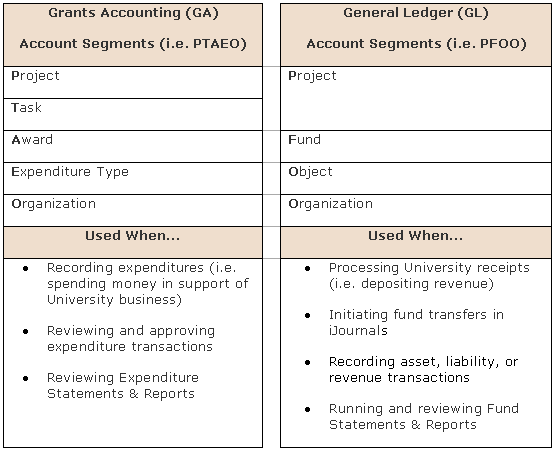Overview: About Stanford's Chart of Accounts
Stanford is a complex organization consisting of many different lines of business; including graduate and undergraduate education, research programs, capital projects, investments, athletic programs, residential housing and dining services, and many more. Stanford's accounting structure, "chart of accounts", must reflect these complexities in order to meet the requirements for tracking revenue and expenses, for accurate analysis and decision making, and for reporting to government agencies, sponsors, and donors.
All employees need to have a basic understanding of Stanford's chart of accounts because all financial transactions and activities (e.g., buying and paying for things, getting reimbursed for business and travel expenses, managing funds, etc.) utilize this accounting structure.
On this page:
- Chart of Accounts Defined
- Chart of Accounts and the Oracle Financial System
- Stanford's Chart of Accounts Structure
- Coding Transactions
- Requesting New PTAs, Expenditure Types or Object Codes
Chart of Accounts Defined
The Chart of Accounts is a set of codes used to classify and record financial transactions in meaningful ways. Stanford's Chart of Accounts structure was designed to:
- Identify specific "pots" of money
- Specify what that money may be used for
- Record the transactions related to that money
The Chart of Accounts enables financial reporting and provides a framework for understanding the financial results of Stanford's operations. The Chart of Accounts consists of segments and descriptive attributes (see below for an example of a Project or Task in the PTAEO account structure) that help the University organize financial information for:
- Internal reporting and financial management
- External reporting and compliance
- Effective management of restricted funds
Chart of Accounts and the Oracle Financial System
The Chart of Accounts is the foundational data structure that controls how financial transactions and balances are collected and stored in the Oracle Financials system. Oracle Financials contains two inter-related accounting modules, Grants Accounting (GA) and General Ledger (GL). Expenditure Type transactions are recorded using Oracle iProcurement, Expense Requests, PCard, iJournals, and Labor Distribution.
The detail behind expenditure transactions is recorded in the Grants Accounting module prior to being summarized and posted to the General Ledger module. All University expenses are posted in Grants Accounting, not just those related to grants. The final repository of all financial transactions and balances (i.e. assets, liabilities, fund balances, revenue, and expenses) is the General Ledger module. Financial information from the Grants Accounting and General Ledger modules is available for analysis using ReportMart3 and Oracle Business Intelligence (OBI) Financial Reporting.
Stanford's Chart of Accounts Structure

See PTAEO and PFOO Defined for a detailed explanation of Stanford's Chart of Account segments and their definition.
For a text version of the above graphic describing the Grants Accounting (i.e. PTAEO) and General Ledger (i.e., PFOO) account structure, click here.
Coding Transactions
Each expenditure transaction that is entered in Oracle Financials (e.g., purchase requisitions, expense reports / reimbursements, PCard verifications, etc.), each transaction in iJournals, and each deposit at the University Payments Office requires a code with the correct PTAEO or PFOO account segments.
There are many Projects, Tasks, and Awards (i.e. Funds) used at Stanford. Some funds are restricted and can only be used for certain types of activities. Other funds are designated for a particular purpose and must be tracked as such. Expenditure Types and Object Codes help track money coming in and out of a fund and determine whether or not a fund is being used appropriately. It is important to understand the rules and restrictions related to the funds you use in order to accurately record revenue and expenditures transactions.
The following resources are available to help properly code transactions:
- How To: Identify Existing Project, Task, Award (PTA)
- Expenditure Type Query (Launch Oracle and open the SU Inquiry Tools folder)
- Expenditure Type Definitions & Rules
- Object Code Listing
- Object Codes: 46XXX Revenue Definitions
- Proper Coding of Allowable and Unallowable University Expenditures
Requesting New PTAs, Expenditure Types or Object Codes
If you find that an existing PTAEO or PFOO account combination does not meet your needs, the following instructions are available to help initiate a new request:
- Request New PTA
- How to update PTA attributes using PTA Manager – PTA Maintenance
- Request New (or Change Existing) Expenditure Type or Object Code


